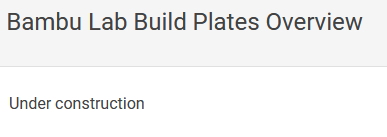This is intended to be constructive criticism and not just complaining. I want to help Bambu Lab be even better. The hardware is fantastic, but the rest needs work.
Method of Delivery
I have no problems with using a wiki for product documentation. It supports linking which is the necessary basic feature.
However, I don’t think the organization of the wiki is very good.
For example, instead of AMS having its own section (being the third product) it is duplicated in both X1 and P1P sections. Wow! I just noticed that this has been fixed and the AMS is now separate. Good job!
The main sidebar is not much help in finding information, because it is both too general and too specific. It leaves most of the organization to page contents in their own sidebar.
Handy and Bambu Studio are lumped under one Sidebar entry.
This leads to very long pages instead of understandable pages with links to other pages. I am sure much of this is due to the choice of wiki software, which is not very good compared to the dozen of so other wiki software applications that I have used (and implemented at companies that I have worked for).
In contrast, if the documentation was a dedicated web site and not a wiki, I would expect the table of contents to be in the sidebar and be hierarchical. Products would be expanded by default to include X1, P1P, AMS, Bambu Studio, and Handy. X1 could be expanded to show User Manual, Maintenance, Troubleshooting, and Known Issues. This is typical of documentation.
The only advantage of using a wiki is to allow users to contribute.
One of the features of standard documentation that is missing is the ability to read every page of the documentation by just going to the next page. This is missing from the wiki. This causes someone like me, who would have read every page to instead ask questions on the forum and get told that I should read the doc because the answer is there.
Documentation Content
I find the content lacking in so many ways. I will focus on Bambu Studio.
Being derived from Prusa Slicer, Bambu Studio does not have to be fully documented. The Prusa documentation could be used for most of the settings. One of the best parts of Prusa Slicer is that it has tool tips that pop up for every setting. In addition it goes one step further and each setting if click on is a link to the documentation page for that setting.
In Bambu Studio, the tool-tips were retained. New setting that have been added are links to the Bambu Lab wiki page. But, probably to avoid advertising for a competitor, Bambu Lab has chosen to punish the user by removing the links from a setting to the Prusa Slicer documentation. So instead of building on a great idea and adding value, Bambu Lab has removed value from Bambu Studio by breading the link to the documentation for 90% of the settings. Sadly, your customers are the ones who are hurt by this.
Now using plates as an example:
I think multiple plates are a good feature. There is documentation for plates and like all the wiki documentation it has lots of pretty pictures. However, the details are missing.

Plates Management has “why you need plates” and other information that should be part of the overview.
You cannot get to Plate Management from the Plate Overview page.
Plate Management talks about what you can do with plates and why they are so great, but does not give you the details you need to actually do those things.
“Support Slicing/Preview/Print based on Plate” but there are no instruction how to do so. When I select a plate and slice it I am taken to preview. Preview has a list of plates at the left. If I select a plate that I have not sliced it slices it with the settings from the first plate. If I slice multiple plates with different settings, no matter which plate I select, the settings show to the left in the preview never change to indicate that the selected plate was sliced with a different profile.
Even something so simple and obvious as how to name the plates does not seem to be documented.
Summary
I think Bambu Lab should put some serious effort into improving the documentation.
In addition consider either a different form of documentation or open the wiki to allow users to help.
(In my world, as a software engineer, the product is not complete until the documentation is done.)